Heating registers: types of structures, calculation of parameters, installation features
There are a huge number of different in design and material manufacturing batteries for heating systems for residential and non-residential premises. But the heating registers among them stand out for their high heat transfer efficiency and ease of self-assembly.
Externally and structurally, these heat exchangers resemble ordinary towel rail coils, but they are much larger in size than their bathroom counterparts.
In the article we presented, the types of heating registers are analyzed in detail, and we will also analyze the features of the installation of such equipment.
The content of the article:
Varieties of heating registers from pipes
The heating register is a classic water-to-air heat exchanger. In most cases, it is made of a smooth-walled metal pipe. The latter is either single or in the form of a series of several segments of the pipeline located horizontally one above the other. In this case, there are separate structures with fins.
A heater made only of a smooth-walled pipe is easier to wash with constant cleaning. There are no plate edges or bottlenecks that are difficult to wipe with a rag. As a result, “colonies” of dust and dirt do not form on such a register. In this regard, he greatly outperforms the now widespread panel-sectional radiators.

The pipe register is not inferior in terms of efficiency of heat energy output and heating costs conventional batteries, and often surpasses them. The total surface area of the heat transfer in both cases is approximately the same, only in the device under consideration the coolant flows through a wide channel.
The hydraulic resistance in this situation is much lower than that in a standard radiator from several panel sections. And this directly affects the energy costs for pumping water through a similar heating circuit.
Types of design
Externally, the heating register does not look too elegant. But it is cheap and easy to manufacture. And if you make a little effort, then such a heater-heat exchanger can quite fit into the interior of even a living room.
In domestic village houses, until recently, a similar version of the heating system was used almost everywhere. In Soviet times, panel-sectional radiators were not on sale, but it was not so difficult to get a wide pipe.
And then only a welding machine was required. The resulting pipe heater is connected to the water heat exchanger inside the wood-burning stove by welding elementarily and quickly. Read more about gas welding battery replacement technology Further.

All types of heating registers are divided into two groups:
- Sectional.
- Coils (S-shaped).
In the first case, horizontal pipes are interconnected by transverse branch pipes of a smaller section, and in the second, by arcs of the same diameter.
Both options involve large volumes of welding. The coil device can also be made by bending one pipe. However, not every tubular article of large diameter made of steel can be bent in this way. It is much easier to take ready-made arcs and weld them to the horizontal segments of the register.
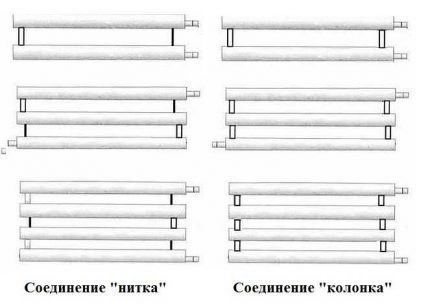
When connecting the horizontal sections of the sectional register with the “column” connection, the cross-piece pipes are welded at both ends. The circulation of the coolant in such a heater takes place in parallel. As a result, individual zones in it may receive less heat. Hot water simply flows into the lower segment before it reaches the far end.
In the "thread", where the coolant passes through all parts of the register, such problems do not arise. In this regard, this register is much like a coil. Only water in it moves from the entrance to the exit of the battery through pipes of different sections.
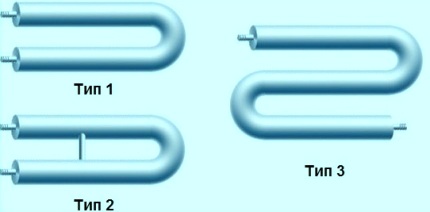
If there are no ready-made arcs for the S-shaped register at hand, then it is better to make a sectional device yourself. It is extremely difficult to bend a large cross-section pipe without special equipment. Almost the only option is to heat the metal with gas welding and carefully bend it. But there is a risk of loss of strength by the walls of the pipe.
Sectional view also includes a register with a pair of side collectors. They are made from pipes of the same diameter as the main sections, playing the role of transverse pipes. Water in this case does not move from top to bottom, but from left to right (or vice versa).
Options for the material of manufacture
Most often, home craftsmen make heating registers from their own hands steel pipes. The main advantages of this option are low cost, material availability and relative ease of welding.

In the factory, registers are issued from:
- steel;
- aluminum;
- copper;
- cast iron.
Leading in heat transfer and durability copper option. But with large sizes, such a heater will cost a pretty penny. An aluminum device is inferior to it in terms of thermal conductivity, but it is also much cheaper.
The most popular and inexpensive type of heating registers is steel.However, this is also the most inefficient option for transferring heat from water to air from all the heat engineering sold in stores.
The thermal conductivity coefficient for different steel ranges from 45–48 W / (m * K). In cast iron it is in the region of 60, in aluminum 200–240, and in copper about 400 W / (m * K). Steel loses to all of them in this technical parameter.
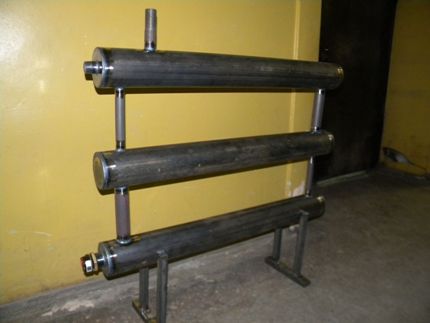
Cast iron and aluminum are usually used only in factory manufacturing registers. It is too difficult to weld these metals independently in artisanal conditions. The same applies to stainless or galvanized steel, so it is better not to take pipes from these materials. They are more difficult to cook, and their heat transfer is lower than that of the usual black counterpart.
With experience in welding copper surfaces, making a register from such pipes is not too problematic. Due to the high heat transfer rates, they can be taken with a smaller diameter than when choosing a steel option. So the heater will be cheaper.
However, copper has a serious drawback here - the need for a neutral and clean coolant. If “dirty” water with impurities circulates in the heating system, you can forget about the long service life of such a battery.
A similar problem is also often observed due to the presence of elements from metals incompatible with copper in the system. Unless a number of precautionary measures are foreseen, such a register will not last long due to electrochemical corrosion.
Devices with a built-in electric heater
The standard version of the register implies its connection to the heating pipes of a centralized system or with a water heating boiler. But there are devices and completely autonomous. In one of the lower pipes, a heating element is built into them, powered by an electric network of 220 V.
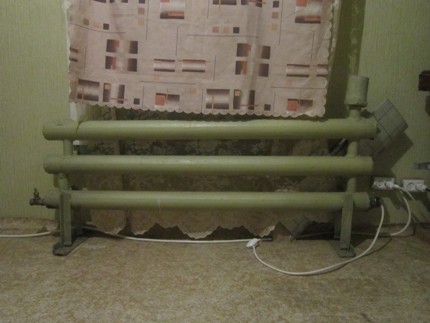
The power of the water-heating element can vary between 1–6 kW, depending on the internal volume of the heat exchanger. Such a heating device is often equipped with a circulation pump so that the coolant reaches all of its sections.
Such an autonomous register is often used as an additional source of heat, which is turned on only in severe frosts. At not too low temperatures outside the window, the room is heated from a common heating system. In addition to water in the electrical register, antifreeze filling is possible.
There is an article on our website where we described in detail the features of the choice and subtleties of connecting the heating elements for heating radiators. More details - go to the link.
Calculation of heater design
First, you need to calculate the required heat output for a particular room.
According to the rules, such a heat engineering calculation should be done taking into account:
- the area and orientation of the external walls (in the southern solar direction or not);
- cubic capacity of a heated room;
- the level of the maximum possible negative temperatures in the region;
- the degree of thermal insulation of the walls facing the street;
- the presence from below and / or above of another heated room;
- quantity, quadrature and variety of installed windows;
- presence / absence of doors that open directly to the street.
Building codes recommend that you even consider the prevailing wind rose in winter. On the windward side of the wall, heat loss during the winter period will be clearly higher.

If the ceilings in the room are located at a level of 3 meters and above, then for a simplified calculation, you should already multiply the cubic capacity of the heated space by 34 or 41 watts.The first coefficient is taken for brick buildings, and the second - for reinforced concrete structures.
Multiplying a pair of numbers is not difficult. But we must clearly be aware that such conditional calculations can be very far from real numbers, since there are many nuances here.
The most optimal solution is to order the necessary calculation from a specialist who will take into account all the parameters of the room. Heat loss occurs through walls, windows, floors, ceilings, and even ventilation. To get the exact numbers, you need to consider everything without exception.
Next, you need to calculate the pipe sizes for the heating register. To do this, use the formula:
Q = K * St * dt
letter designations:
- Q is the thermal power of the register;
- K - heat transfer coefficient, depends on the pipe material;
- St - heat transfer area (equal to the number of PI times the diameter and length of the pipe);
- dt is the heat head.
Accordingly, knowing Q and dt, it remains only to choose the pipe diameter and its total length. Then, depending on the design of the register, this pipeline can be divided into several segments, which will subsequently be connected by cross members. The heat transfer from the latter, in order not to complicate the calculations, is better not to take into account.
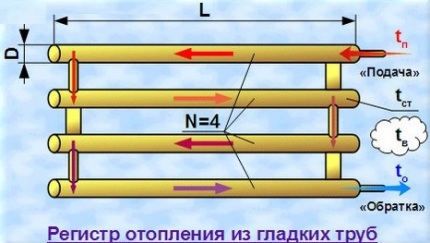
When connecting the pipes with a snake, each subsequent horizontal segment receives approximately 10% less thermal energy than that located above. Each such segment of the register pipeline should be considered as a separate battery. And the heat carrier as it moves along them gradually and inevitably cools, the heat goes into the room.
Another parameter is the distance between horizontal sections (main pipes), which reflects the height of an individual pipe. If this clearance is made too small, then the heat flows from above and below will begin to overlap, adversely affecting each other.
This figure must be selected so that it is slightly larger than the diameter of the pipe. Then the effectiveness of the register will be the highest possible.
With more detailed calculations of the power of the heating batteries and their number can be read here.
Features of the installation
There is nothing particularly complicated in setting up a heating register. Difficulties are possible only when welding from individual pipes. If there is not much experience in welding, it is best to practice first. When buying a prefabricated factory-made device, installation problems should not arise at all.
Hanging on the walls of the pipe register is done using powerful brackets (hooks). If it is placed on the floor, then enough iron legs. It is important to remember that the steel heater in question weighs quite a lot. Plus, the weight of the water inside is added, so the mounts and stands should be super reliable.
The ends of the pipe section are closed with special spherical plugs or welded using small steel rounds cut from sheet metal. Fittings with external thread for installing an air exhaust valve and connecting to the heating system cut directly into the pipe wall or into the end plate.
The surface of a battery made of steel should be coated with heat-resistant paint. Thanks to it, the device will not only become externally more aesthetically pleasing, but also gain additional anti-corrosion protection.
You can read the detailed instructions for creating DIY heating registers in this stuff.
Conclusions and useful video on the topic
The videos collected below will help you understand all the nuances of the calculations of the heating register and its installation in the room.
Technology for manufacturing a register from a rectangular profile pipe:
Advantages and calculation of the power of the heating register:
If you want to heat a large cubic room, then the register of smooth-walled steel pipes is ideal for this. If you have the skill to perform welding work, it is not difficult to assemble such a homemade battery with your own hands. It is only necessary to accurately calculate the parameters of this device and choose the right tubular products for it.
Have questions, find bugs or is there valuable information that you can share with visitors to our site? Please leave your comments, ask questions in the feedback form located under the article.

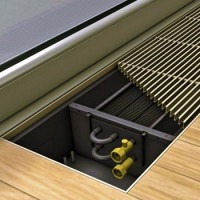 Water floor heating convectors: types, features of installation and arrangement
Water floor heating convectors: types, features of installation and arrangement 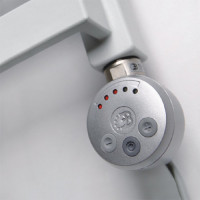 Heating elements for heating radiators: purpose, types, selection criteria, connection features
Heating elements for heating radiators: purpose, types, selection criteria, connection features 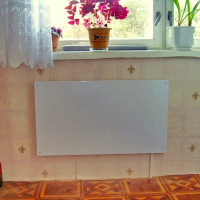 Infrared heating panels: types, principle of operation, features of installation and operation
Infrared heating panels: types, principle of operation, features of installation and operation 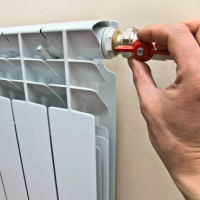 Aluminum heating radiators: overview of technical characteristics + installation principles
Aluminum heating radiators: overview of technical characteristics + installation principles 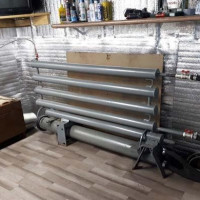 How to make a heating register with your own hands: assembly and installation instructions
How to make a heating register with your own hands: assembly and installation instructions 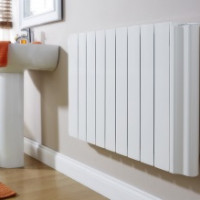 Vacuum heating radiators: overview of types, selection rules + installation technology
Vacuum heating radiators: overview of types, selection rules + installation technology  How much does it cost to connect gas to a private house: the price of organizing gas supply
How much does it cost to connect gas to a private house: the price of organizing gas supply  The best washing machines with dryer: model rating and customer tips
The best washing machines with dryer: model rating and customer tips  What is the color temperature of light and the nuances of choosing the temperature of the lamps to suit your needs
What is the color temperature of light and the nuances of choosing the temperature of the lamps to suit your needs  Replacement of a geyser in an apartment: replacement paperwork + basic norms and requirements
Replacement of a geyser in an apartment: replacement paperwork + basic norms and requirements
For sure, the heating registers from pipes in terms of heat transfer are beyond competition, according to my observations. Outwardly, of course, not everyone likes this, but for large rooms, especially industrial ones, I haven’t seen anything cheaper and more efficient. And about the appearance, by the way, in the presence of a designer vein, it is very interesting to beat and even style out. Especially for lofts relevant.
He put heating registers from pipes in his garage under the house. I know how to cook myself, steel pipes of large diameter were, and it makes sense to buy new sectional batteries, I saw her. The only problem was I had to calculate the power, my father-in-law called, he is my engineer, so in a couple of minutes he figured everything out in his mind, he counted the meter, looked at my pipes and said that would be enough. Made a serpentine, heated very efficiently, warmly in the garage in winter. The beauty!